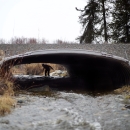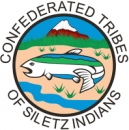States
OregonThis project will remove old road and dike infrastructure and reconnect two miles of Fivemile Creek in Oregon to provide juvenile fish access for rearing and foraging habitat. The increased access and improved vegetation will benefit threatened Oregon Coast coho, Pacific lamprey, western brook lamprey, Oregon Coast steelhead, coastal cutthroat trout, freshwater mussels and a host of native plants and invertebrates. Restoring system connectivity will increase climate resiliency and improve productivity of fisheries significant to the Confederated Tribe of the Siletz Indians.
Project Quick Facts:
| Project Status | In Development |
| Location | OR, Douglas County |
| NFPP Project Funding | $200,000 |
| Restoration Techniques | Dike Removal, Channel Reconstruction |
| Accomplishments | 8 Stream Miles Reopened, 41 Acres Reopened |
| Partner Project Lead | Confederated Tribe of the Siletz Indians |
The National Fish Passage Program combines technical expertise with a track record of success.
Implemented primarily through the Service's Fish and Wildlife Conservation Offices, the National Fish Passage Program provides financial and technical assistance to partners across the country. Since 1999, the program has worked with over 2,000 local communities, Tribes, and private landowners to remove or bypass over 3,400 barriers to fish passage fish passage
Fish passage is the ability of fish or other aquatic species to move freely throughout their life to find food, reproduce, and complete their natural migration cycles. Millions of barriers to fish passage across the country are fragmenting habitat and leading to species declines. The U.S. Fish and Wildlife Service's National Fish Passage Program is working to reconnect watersheds to benefit both wildlife and people.
Learn more about fish passage and reopen access to over 61,000 miles of upstream habitat for fish and other animals. Staff have expertise in fish migration and biology as well as financial, engineering, and planning assistance to communities, Tribes, and landowners to help them remove barriers and restore rivers for the benefit both fish and people.
Fish passage project proposals can be initiated by any individual, organization, government, or agency. However, proposals must be submitted and completed in cooperation with a Fish and Wildlife Conservation Office. (Please note that fish passage projects being used for federal or state compensatory mitigation or required by existing federal or state regulatory programs are not eligible for funding through the National Fish Passage Program.)
CONTACT A FISH PASSAGE COORDINATOR IN YOUR AREA TO GET STARTED.


